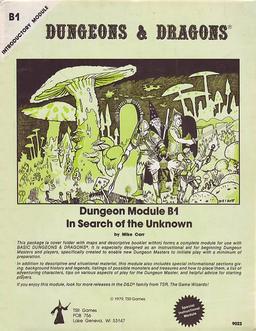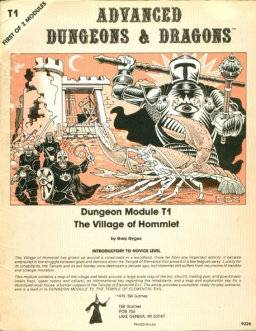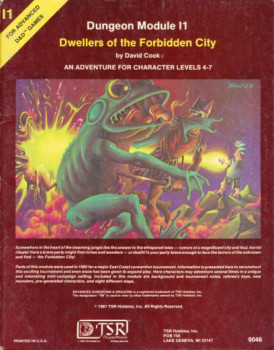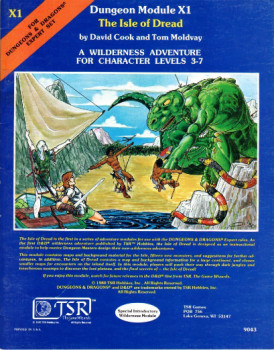Four Modules
 One of the many interesting divides among devotees of “old school” roleplaying games, particularly those who favor Dungeons & Dragons, concerns the place of the adventure module. An adventure module is a product detailing a locale to be explored or a situation to be resolved. By many reckonings, the first such module appeared in 1976, written by Pete and Judy Kerestan. Entitled Palace of the Vampire Queen, it described the five-level dungeon inhabited by undead – including the Vampire Queen herself – and other unpleasant things. Held captive within the dungeon is the daughter of a dwarf king, providing a motivation for the characters to become involved beyond glory and gold. While it isn’t notably clever in its conceptions, the module was groundbreaking in that it showed there was market for prefabricated, portable adventures rather than relying solely on the referee’s own efforts. It’s little wonder, then, that modules quickly became a staple of TSR’s catalog, as well as those of other publishers.
One of the many interesting divides among devotees of “old school” roleplaying games, particularly those who favor Dungeons & Dragons, concerns the place of the adventure module. An adventure module is a product detailing a locale to be explored or a situation to be resolved. By many reckonings, the first such module appeared in 1976, written by Pete and Judy Kerestan. Entitled Palace of the Vampire Queen, it described the five-level dungeon inhabited by undead – including the Vampire Queen herself – and other unpleasant things. Held captive within the dungeon is the daughter of a dwarf king, providing a motivation for the characters to become involved beyond glory and gold. While it isn’t notably clever in its conceptions, the module was groundbreaking in that it showed there was market for prefabricated, portable adventures rather than relying solely on the referee’s own efforts. It’s little wonder, then, that modules quickly became a staple of TSR’s catalog, as well as those of other publishers.
The issue some old schoolers take with adventure modules is that they, to borrow Gygax’s famous phrase from Volume 3 of the 1974 edition of D&D, “do … your imagining for you.” More importantly, modules unconsciously establish not only a notion of what an adventure is and ought to be, but they also establish the outlines of a fantasy setting rather than leaving all of these up to each referee to decide for himself and his own campaign. I’m somewhat sympathetic to this point of view, since I know well how powerful an influence TSR’s modules exercised over my own youthful imagination. At the same time, many of these modules served as helpful models to me as I started creating my own dungeons, adventures, and settings. Likewise, they provided a point of commonality between myself and other players, regardless of where they lived or with whom they played. When I met others at local games meets or conventions (or, nowadays, online), we can reminisce about our shared experiences fighting through the Caves of Chaos or the wonders we saw when we first beheld dark fairyland of the Vault of the Drow.
With hindsight, I can pick out four adventure modules published by TSR Hobbies that had a profound impact on me, both in terms of how I viewed Dungeons & Dragons and how I went about creating my own adventures for my group of friends. The first was Mike Carr’s In Search of the Unknown. Designated module B1, since it was the first module intended for use with the Basic Set with which it was initially packaged. That’s how I first encountered it, which undoubtedly explains why, of the four modules I’ll talk about, it’s the one whose influence is most potent, even thirty-five years after the fact.
Unlike the other modules in this post, In Search of the Unknown is the only one that was explicitly written and presented as a tutorial. In addition to providing heaps of advice and suggestions for the novice referee, B1 presents a two-level dungeon whose more mundane – a relative term! – contents are described, but whose inhabitants (i.e. monsters) are not. Instead, the referee is instructed to choose monsters (and treasures) from a list and place them where he feels appropriate. The list contains more monsters and treasures than ought to be used in order to give the neophyte game master plenty of choice. The text also reminds him to leave a large number of rooms empty, since, contrary to latter day snark, old school dungeons were not chock-a-block with vicious beasties.
 In Search of the Unknown was thus a dungeon with “training wheels,” something I very much appreciated in my early days as a D&D referee. It held my hand just enough to teach me what dungeon maps should look like and how to stock them. In this purpose, I think it’s unsurpassed, which is why I think it a shame that later versions of the Basic Set (both the version I owned and the later 1981 edition) included The Keep on the Borderlands instead. That’s no knock against module B2, which is a classic in its own right, but it’s not very good as a tutorial for tyros.
In Search of the Unknown was thus a dungeon with “training wheels,” something I very much appreciated in my early days as a D&D referee. It held my hand just enough to teach me what dungeon maps should look like and how to stock them. In this purpose, I think it’s unsurpassed, which is why I think it a shame that later versions of the Basic Set (both the version I owned and the later 1981 edition) included The Keep on the Borderlands instead. That’s no knock against module B2, which is a classic in its own right, but it’s not very good as a tutorial for tyros.
The second module that influenced me greatly was published the same year as module B1, The Temple of Elemental Evil. Written by Gary Gygax, it was designated module T1 and billed as the “lead-in” to the never released module T2 (There was a T1-4 “super-module” released in 1985, but I don’t think very highly of it). One of the things that concerned me early on in my refereeing was getting a handle on what the world outside the dungeon was like. My friends and I all assumed there was a town or city nearby to which the characters would go for supplies and healing in between subterranean excursions, but what was this place like?
The Village of Hommlet gave one possible answer by detailing a small farming community located not far from the infamous ruins of the Moathouse, once an outpost of nefarious Temple of Elemental Evil. The Moathouse dungeon is well-done. Though self-contained, even limited, there are a number of memorable encounters within – the ghouls and giant crayfish come immediately to mind – it has a surprising amount of implied depth. Likewise, the nature of inhabitants and their activities suggest that all is not well in Hommlet itself. The brilliance of this module, for me anyway, is that it shows that adventures can happen anywhere, even in a sleepy little agricultural community. To a lot of you reading this, that’s a tired trope, one used for decades, if not longer, in literature. But as a young kid new to roleplaying games, it was nothing short of a revelation.
T1 holds a special place in my heart for another reason. Because the promised module T2 never appeared, I was forced to create my own version of the Temple of Elemental Evil, using what clues I could glean from T1 as spurs to my own imagination. However disappointed I was in the later published version of the Temple, I’d never claim my own was “better,” except in the sense that I made it and my friends and I had fun playing through it. In that respect, I consider the “incomplete” nature of The Village of Hommlet to be a positive thing that inadvertently encouraged me to spread my wings as a fledgling referee. Far from stifling my creativity, this module fostered it.
 The third adventure module on my list is David Cook’s Dwellers of the Forbidden City, released in 1981. Designated I1, the module describes a ruined city located deep in a nearly inaccessible part of the jungle. Once the center of a great and powerful civilization, the city fell into its current state as the result of its rulers turning to evil and unspeakable rites that, over time, made them less than human. These descendants, the snake-like yuan-ti, now hold court amongst the rubble, occasionally sending out raiding parties to harry their unsuspecting neighbors. It’s precisely because the yuan-ti’s recent attacks on merchant caravans that the characters become involved in this adventure.
The third adventure module on my list is David Cook’s Dwellers of the Forbidden City, released in 1981. Designated I1, the module describes a ruined city located deep in a nearly inaccessible part of the jungle. Once the center of a great and powerful civilization, the city fell into its current state as the result of its rulers turning to evil and unspeakable rites that, over time, made them less than human. These descendants, the snake-like yuan-ti, now hold court amongst the rubble, occasionally sending out raiding parties to harry their unsuspecting neighbors. It’s precisely because the yuan-ti’s recent attacks on merchant caravans that the characters become involved in this adventure.
Dwellers of the Forbidden City is a pulp delight, filled as it is with frog and monkey men, dark sorceries, and weird monstrosities. I also see the clear influence of Robert E. Howard’s “Red Nails” on the adventure, with the Forbidden City standing in for Xuchotil. More than that, it’s a good example of what I’d call an “urban wilderness.” Rather than forests and hills, the landscape is littered with ruined buildings and structures, many of which function as the dwelling places of intelligent beings, who form their own societies in the shadow of the yuan-ti’s villainy. Unlike a “proper” wilderness, though, the scale of the city, while large, is not measured in many miles. It is, however, much larger than the typical dungeon, meaning that any expedition into it will move much more slowly and need to be appropriately supplied to survive.
My fondness for I1 goes beyond its specific contents. Unlike many adventure modules, I used Dwellers of the Forbidden City multiple times for many different groups of players. Not only did I become very knowledgeable about its contents, making it easy for me to use, but I also enjoyed seeing how the various groups interacted with it. I encountered many approaches, with some simply blundering into the place and heading straight for the yuan-ti, while others took the time to explore and make alliances with the various factions with the Forbidden City. It’s a module that really can be used to good effect in multiple ways, a lesson I took to heart in my own adventures, even if I often failed to succeed as well as Cook did here.
 My final module is X1, The Isle of Dread, written by David Cook and Tom Moldvay and first published in 1981. (Is it any wonder I consider the years between 1979 and 1981 to have been D&D‘s undisputed high point?) Like most gamers who owned this module, I acquired it through the Expert Set released the same year. Though I had by this point “graduated” to playing Advanced Dungeons & Dragons, I was hungry enough for new material that I even bought stuff for the “kiddie” versions of the game. In the case of The Isle of Dread, I am very glad I did.
My final module is X1, The Isle of Dread, written by David Cook and Tom Moldvay and first published in 1981. (Is it any wonder I consider the years between 1979 and 1981 to have been D&D‘s undisputed high point?) Like most gamers who owned this module, I acquired it through the Expert Set released the same year. Though I had by this point “graduated” to playing Advanced Dungeons & Dragons, I was hungry enough for new material that I even bought stuff for the “kiddie” versions of the game. In the case of The Isle of Dread, I am very glad I did.
Though not as explicitly a tutorial as In Search of the Unknown, module X1 nevertheless seems to have been intended as an introduction to wilderness adventuring, which was covered at some length in the Expert Rules. The eponymous Isle is a Lost World kind of place, filled with dinosaurs, giant mammals, primitive natives, and lurking evil. The framing device of the entire adventure is survival, as the characters find themselves shipwrecked while seeking the legendary treasure of an earlier adventurer. Consequently, they have to contend with the problems of wandering through in inhospitable terrain, finding food and shelter, and avoiding the Isle’s deadly inhabitants, all the while hoping to find a way to get back to civilization. It’s a classic set-up whose echoes of Sir Arthur Conan Doyle appealed to me greatly as a kid.
Strange though it may seem, what The Isle of Dread did best was show me that D&D encompassed a lot more than medieval fantasy. On some level, I already knew this, of course, but this module hit that home, with its evocation of Victorian adventure tales and the historical exploration of Africa. Similarly, it showed me that not everything had to “make sense” so long as it was fun. I was – and probably still am to some degree – unduly concerned with verisimilitude, even in my fantasies. The Isle of Dread cares not one whit about such things, gleefully serving up Tyrannosauruses, magic-using spiders, cat people, and ruins filled with evil, heat-loving amphibians. There’s no rhyme or reason to it, but it’s all incredibly evocative and a blast to play, which, in the end, are the only measures by which any adventure module should be judged.
I was not familiar with In Search of the Unknown, because by the time I started playing D&D they’d already switched over to The Keep on the Borderlands as the introductory module (I have fond memories of the latter, probably not because of any inherent merits but because it was the first one I led my sister and my sixth-grade buddies through!).
I did, however, recently purchase a copy of In Search of the Unknown through eBay. Both the title and that cover illustration of the giant mushroom forest evoke the sort of wonder, mystery, and adventure I anticipated from those early games, and from fantasy in general.
Like you, I’ve been revisiting (or, sometimes, visiting for the first time) these old tomes. Looking back thirty years later, I believe it can legitimately be claimed that those early RPGs — with D&D holding a central place in that cultural phenomenon — are historically and culturally significant enough to merit more serious attention from historians and scholars (if only as highly-influential pop-cultural texts if not as works of great literature).
Thanks for these ongoing tours back to fond memories and magical times!
You mention the aspect of modules constraining the referee (I’m paraphrasing). I get that’s a valid viewpoint that’s been out there for decades.
But there’s the alternative that not every referee is good at making up interesting and fun campaign settings and adventures.
They might even think they are, but, at least in the early days, the premise was that modules from TSR and Judges Guild were done by “professionals.” Which you could expect to be better than the one your sixth grade buddy came up with.
I remember going through F’Dech Fo’s Tomb from JG. I can’t imagine playing something that simple now, but it was better than my friend’s Dungeon of Death or whatever it was called.
Reading the tutorial aspect of ‘In Search of the Unknown’ reminded me of Necromancer Games’ ‘The Wizard’s Amulet’, which was very much in the same vein for third edition.
It walked the new GM (well, at least new to third edition) through encounters and how to run an adventure.
And that led into ‘The Crucible of Freya’ and then, just about my favorite 3rd edition module, ‘The Tomb of Abysthor.’
There’s a place for that kind of introductory module for the newcomer.
Bob Byrne — Don’t sell your friend’s “Dungeon of Death” short! I’m sure it had some inspired mayhem from a sixth-grader’s-imagination. 🙂
Nick – If I remember correctly, I think we slogged through Tegel Manor instead. A lotta fun going nowhere.
Which lives on in spirit in Frog God Games’ The Black Monastery!
[…] versions of the game. My Basic Set also included an adventure module, In Search of the Unknown, about which I talked before and its two-level dungeon exercised an equally strong influence over my young […]